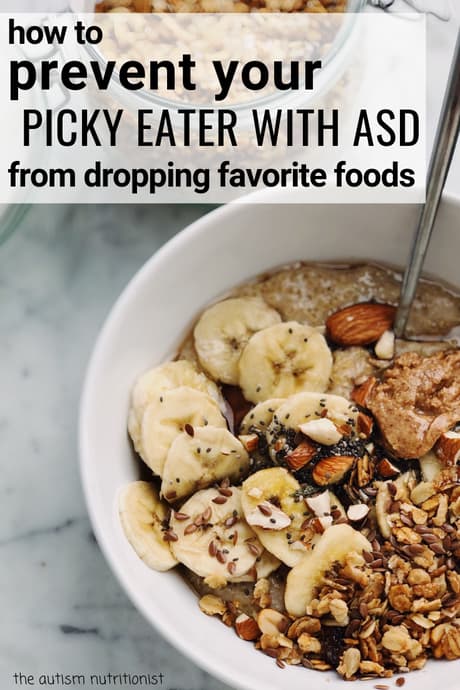
Lindsay came to me really worried. Two years ago her son, Rex, a 5-year-old with autism, used to eat over a dozen foods. He was always a selective eater, but had a solid list of favorites, so she wasn’t too concerned.
That changed when Rex slowly started refusing to eat some of his longtime favorites like yogurt. Lindsay was hoping this was just a weird picky eating phase, but Rex’s list kept getting smaller.
That’s when she called me.
I remember this used to happen with my little brother. My mom would stock up on his favorite snack from Costco only to have him one day decide he just didn’t want it any more.
The sudden rejection of a favorite food is known as a food jag. It’s pretty common for kids – even those known as good eaters – to go through eating phases. In traditional picky kids, the food jag unjags and just as suddenly as they stopped eating a food, they decide it’s back on their favorite list.
In autism and other feeding disorders, jags often seem permanent. Like Rex, a child will reject, but never welcome back an increasing number of foods until his or her list of accepted foods is extremely limited.
A child’s food preferences may seem totally random and fickle – one day it’s this, the next day it’s that. And while some of this is just the nature of feeding a child, there are strategies you can use to can prevent food jags from developing.
Try these three tips for preventing food jags in your picky eater with autism:
Make small changes to preferred food item
Small changes accomplish a few things. They:
-
Break up the monotony, so every eating experience is a little different
-
Open up opportunities to try new foods
-
Challenge a child’s sensory system
-
Decrease the likelihood of a child feeling like s/he is eating the very same thing every day
What are some examples of small changes you can make?
Include child when making changes to preferred food
Agency goes a far way. Including a child in food choices helps them feel in control. This decreases anxiety about eating and is associated with improved consumption. Include your child in food shopping and cooking when able. Try a version of these questions to include them in making the changes in their preferred foods:
-
What spices should we add? Do you prefer cinnamon or maple syrup?
-
What shape should we cut your toast today? Do you want triangles or strips?
Introduce a new brand of your child’s preferred foods
Brand specificity is so common in picky kids with autism. Building up your child’s comfort with multiple brands of the same type of food means that even if s/he jags on one, there are still other options to offer. It’s also helpful to serve packaged foods outside of their packages on your usual plates and cups.
Recap
Food jags are common in children. Selective eaters on the autism spectrum tend to stop eating foods without ever adding them back into their diets. You can prevent food jags by making small changes to the foods your child eats, include your child in food decisions, and serve your child multiple brands of foods on your usual plates and from your usual cups.
Homework
Identify one area that you can incorporate into your routine in the next few days. Once you’ve got that one under your belt and your child has adjusted, add another!


0 Comments